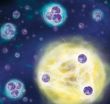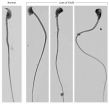(Press-News.org) Much like using dimmer switches to brighten or darken rooms, biochemists have identified a protein that can be used to slow down or speed up the growth of brain tumors in mice.
Brain and other nervous system cancers are expected to claim 14,320 lives in the United States this year.
The results of the preclinical study led by Eric J. Wagner, Ph.D., and Ann-Bin Shyu, Ph.D., of The University of Texas Health Science Center at Houston (UTHealth) and Wei Li, Ph.D., of Baylor College of Medicine appear in the Advance Online Publication of the journal Nature.
"Our work could lead to the development of a novel therapeutic target that might slow down tumor progression," said Wagner, assistant professor in the Department of Biochemistry and Molecular Biology at the UTHealth Medical School.
Shyu, professor and holder of the Jesse H. Jones Chair in Molecular Biology at the UTHealth Medical School, added, "This link to brain tumors wasn't previously known."
"Its role in brain tumor progression was first found through big data computational analysis, then followed by animal-based testing. This is an unusual model for biomedical research, but is certainly more powerful, and may lead to the discovery of more drug targets," said Li, an associate professor in the Dan L. Duncan Cancer Center and Department of Molecular and Cellular Biology at Baylor.
Wagner, Shyu, Li and their colleagues discovered a way to slow tumor growth in a mouse model of brain cancer by altering the process by which genes are converted into proteins.
Appropriately called messenger RNA for short, these molecules take the information inside genes and use it to make body tissues. While it was known that the messenger RNA molecules associated with the cancerous cells were shorter than those with healthy cells, the mechanism by which this occurred was not understood.
The research team discovered that a protein called CFIm25 is critical to keeping messenger RNA long in healthy cells and that its reduction promotes tumor growth. The key research finding in this study was that restoring CFIm25 levels in brain tumors dramatically reduced their growth.
"Understanding how messenger RNA length is regulated will allow researchers to begin to develop new strategies aimed at interfering with the process that causes unusual messenger RNA shortening during the formation of tumors," Wagner said.
Additional preclinical tests are needed before the strategy can be evaluated in humans.
"The work described in the Nature paper by Drs. Wagner and Shyu stems from a high-risk/high-impact Cancer Prevention & Research Institute of Texas (CPRIT) proposal they submitted together and received several years ago," said Rod Kellems, Ph.D., professor and chairman of the Department of Biochemistry and Molecular Biology at the UTHealth Medical School.
"Their research is of fundamental biological importance in that it seeks to understand the role of messenger RNA length regulation in gene expression," Kellems said. "Using a sophisticated combination of biochemistry, genetics and bioinformatics, their research uncovered an important role for a specific protein that is linked to glioblastoma tumor suppression."
Other UTHealth contributors include postdoctoral fellow Chioniso P. Masamha, Ph.D.; research associate Todd R. Albrecht; and neurosurgery associate professor Min Li, Ph.D., along with a postdoctoral fellow in his lab, Jingxuan Yang, Ph.D.
"Grade IV astrocytomas (GBM) are the most frequent and malignant form of brain tumor, with a median survival time of only 14.6 months. The mechanisms underlying gliomagenesis remain largely unknown, and limited choices are available for patients with GBM," said Min Li, director of the Cancer Research Program in the Vivian L. Smith Department of Neurosurgery at UTHealth and a member of the Mischer Neuroscience Institute at Memorial Hermann-Texas Medical Center.
INFORMATION:
Wagner, Shyu and Min Li are on the faculty of The University of Texas Graduate School of Biomedical Sciences at Houston. Zheng Xia, Ph.D., a postdoctoral in the laboratory of Wei Li, also contributed to the study.
The study titled "CFIm25 links Alternative Polyadenylation to Glioblastoma Tumour Suppression" received support from the Department of Defense (W81XWH-11-1-0304, W81XWH-12-1-0218 and W81XWH-10-1-0501), National Institutes of Health grants (GM046454, CA167752, CA166274 and HG007538), CPRIT (RP100107 and RP110471-C3), the Houston Endowment, Inc., the Marnie Rose Foundation and the William and Ella Owens Medical Research Foundation.
Scientists slow brain tumor growth in mice
2014-05-13
ELSE PRESS RELEASES FROM THIS DATE:
Birth by C-section, early antibiotic use put kids at risk for allergic esophagitis
2014-05-13
Children delivered by cesarean section and those given antibiotics during early infancy appear more prone to developing allergic inflammation of the esophagus — the muscular tube that connects the mouth to the stomach — according to results of a study by investigators from the Johns Hopkins Children's Center and Harvard Medical School.
The findings, published online May 2 in the Journal of Allergy and Clinical Immunology: In Practice, reveal that early antibiotic treatment and C-section delivery may somehow precipitate disease development by altering a child's microbiota ...
Professional surfer back in the water after successful surgery to treat rare bone cancer
2014-05-13
LOS ANGELES (May 13, 2014) – When professional surfer Richie Lovett began experiencing hip pain at 31, he attributed it to his athletic lifestyle. But after months of discomfort and preliminary tests, the Australian native learned the pain was caused by a cancerous tumor in his femur or thigh bone.
"As a professional athlete, I was blindsided by the news that I had cancer," said Lovett. "I realized very quickly that cancer would have a profound effect on my life. I knew I needed an experienced oncologist to tackle this disease, so I began an international search to find ...
Quantum trimer -- from a distance
2014-05-13
Eight years ago Rudolf Grimm's research group was the first to observe an Efimov state in an ultracold quantum gas. The Russian physicist Vitali Efimov theoretically predicted this exotic bound state of three particles in the 1970s. He forecast that three particles would form a bound state due to their quantum mechanical properties, under conditions when a two-body bound state would be absent. What is even more astounding: When the distance between the particles is increased by factor 22.7, another Efimov state appears, leading to an infinite series of these states. Until ...
Researchers identify link between colon cancer and metabolism
2014-05-13
HEIDELBERG, 13 May 2014 – More than 60 years ago Otto Warburg recognized that cancer cells differ from normal cells in the metabolic pathway they use for the oxidation of sugar. Rather than the typical series of oxidative steps that take place in the citric acid cycle, cancer cells metabolize sugar via the glycolytic pathway irrespective of whether oxygen is present or not. In The EMBO Journal, researchers in the United States report that the reason for this difference in colon cancer is changes in the Wnt signaling pathway, an essential communication pathway operating ...
Dangerous nitrogen pollution could be halved
2014-05-13
Ambitious mitigation efforts, however, could decrease the pollution by 50 percent. The analysis is the very first to quantify this.
"Nitrogen is an irreplaceable nutrient and a true life-saver as it helps agriculture to feed a growing world population – but it is unfortunately also a dangerous pollutant," says Benjamin Bodirsky, lead-author of the study. In the different forms it can take through chemical reactions, it massively contributes to respirable dust, leads to the formation of aggressive ground-level ozone, and destabilizes water ecosystems. Damages in Europe ...
Male infertility: It's all about the package
2014-05-13
Cold Spring Harbor, NY – Infertility is generally thought of as a woman's problem. In fact, more than 3 million men across America also experience it. Today, researchers from Cold Spring Harbor Laboratory (CSHL) describe a key event during sperm development that is essential for male fertility. A team led by CSHL Professor Alea Mills explains how a protein controls DNA packaging to protect a man's genetic information.
The sperm is a simple delivery vehicle for a man's genetic information. The highly specialized cell is little more than a DNA bundle powered by molecular ...
Concerns raised over EU ban on ditching unwanted fish
2014-05-13
New rules banning fishermen from throwing away unwanted fish they have caught could harm wildlife – and fail to improve fish stocks, a University of Strathclyde report has found.
The study, published in the journal Nature Communications, suggests new reforms to the European Union's Common Fisheries Policy (CFP) – ending the practice of throwing away unwanted fish caught at sea – may have unintended consequences. The new CFP took effect on 1 January 2014 and will phase out the discarding of fish between 2015 and 2019.
The aim is to improve fish stocks – but Professor ...
Researchers identify genetic marker linked to OCD
2014-05-13
A group of researchers led by Johns Hopkins scientists say they have identified a genetic marker that may be associated with the development of obsessive-compulsive disorder (OCD), whose causes and mechanisms are among the least understood among mental illnesses.
The results of the research are published online May 13 by the journal Molecular Psychiatry.
"If this finding is confirmed, it could be useful," says study leader Gerald Nestadt, M.D., M.P.H., a professor of psychiatry and behavioral sciences at the Johns Hopkins University School of Medicine and director of ...
Humans and companion animals harbor the same types of MRSA infections
2014-05-13
A shared population of methicillin-resistant Staphylococcus aureus (MRSA) bacteria circulates both in humans and companion animals, according to a study published this week in mBio®, the online open-access journal of the American Society for Microbiology.
"Our study demonstrates that humans and companion animals readily exchange and share MRSA bacteria from the same population," says senior author Mark Holmes, senior lecturer in preventive veterinary medicine at the University of Cambridge in England. MRSA naturally lives on the skin and also causes difficult-to-treat ...
E-cigarettes and mental health
2014-05-13
Researchers at University of California, San Diego School of Medicine report that people living with depression, anxiety or other mental health conditions are twice as likely to have tried e-cigarettes and three times as likely to be current users of the controversial battery-powered nicotine-delivery devices, as people without mental health disorders.
They are also more susceptible to trying e-cigarettes in the future in the belief that doing so will help them quit, the scientists said. The FDA has not approved e-cigarettes as a smoking cessation aid.
The study will ...



